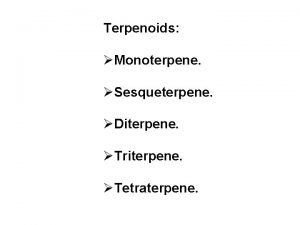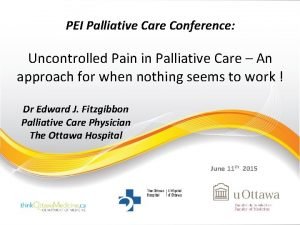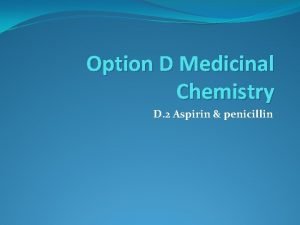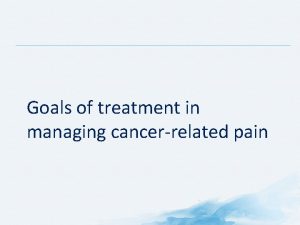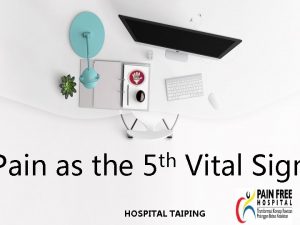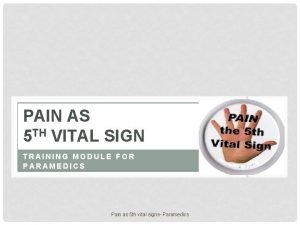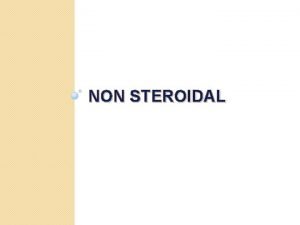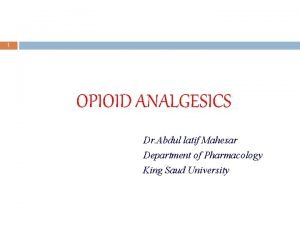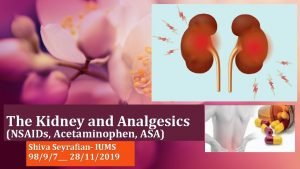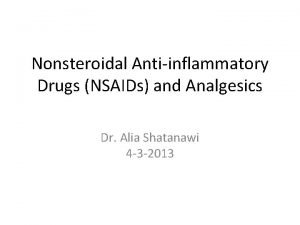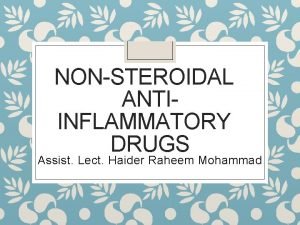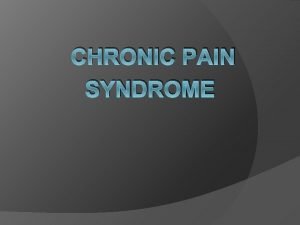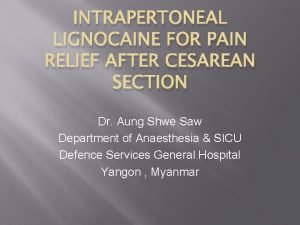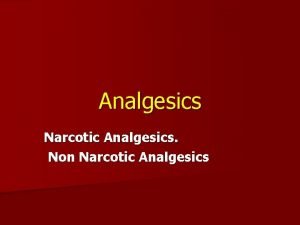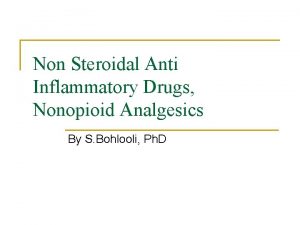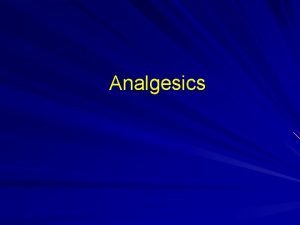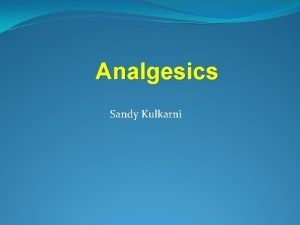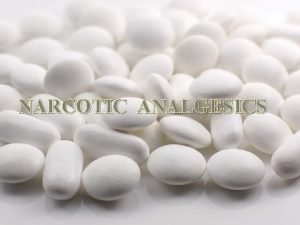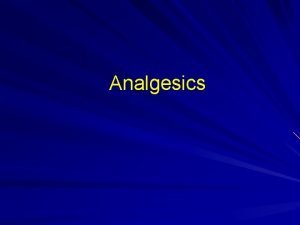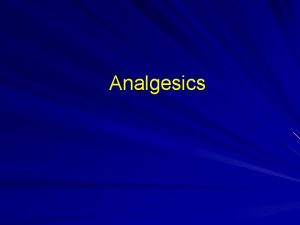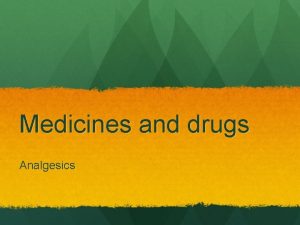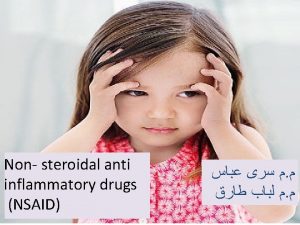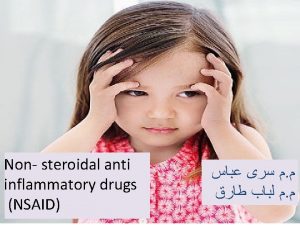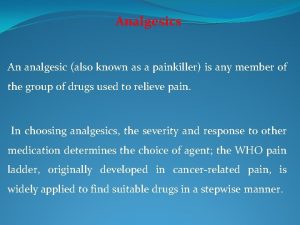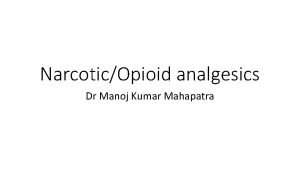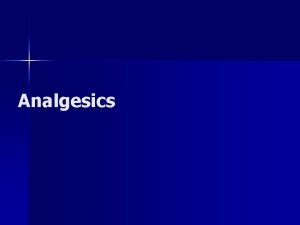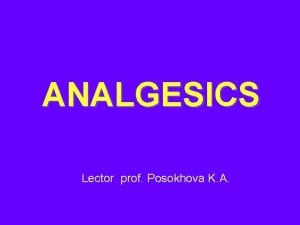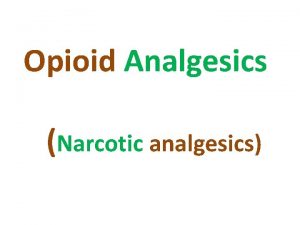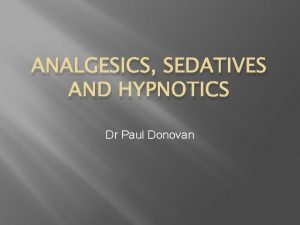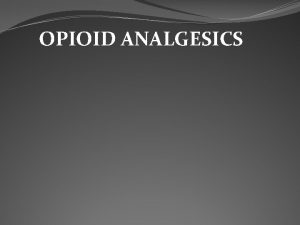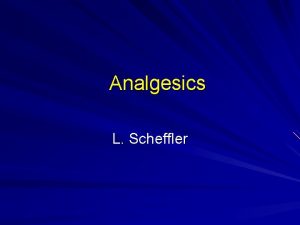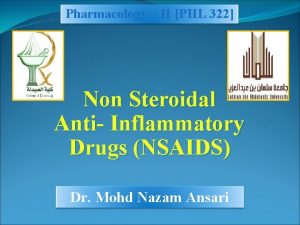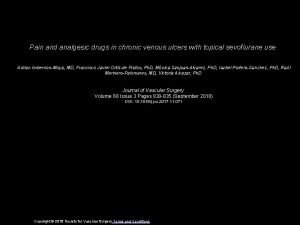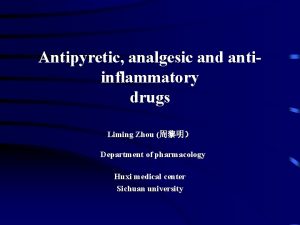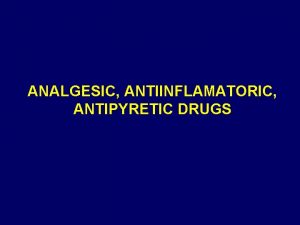NON STEROIDAL ANALGESIC S Analgesics are drugs that




























- Slides: 28

NON STEROIDAL

ANALGESIC S • Analgesics are drugs that relieve pain without significantly altering consciousness. • They relieve pain without affecting its cause.

Classificatio n 1. Nonselective cyclooxygenase (COX) inhibitors Salicylates: Aspirin Propionic acid derivatives: Ibuprofen, ketoprofen, naproxen Acetic acid derivatives: Diclofenac. Fenamic acid derivatives: Mefenamic acid. Pyrrolo–pyrrole derivatives: Ketorolac, etodolac. Indole derivatives: Indomethacin. 2. Highly selective COX-2 inhibitors: Celecoxib. 3. Preferential COX-2 inhibitors: Meloxicam. 4. Analgesic—antipyretics with poor anti-inflammatory effect: Paracetamol

Mechanism of Action

Pharmacological actions of Aspirin and other NSAIDs • Analgesic effect – mainly used for relieving musculoskeletal pain. – dysmenorrhoea and pain associated with damage. inflammation or tissue – Analgesic effect is mainly due to peripheral inhibition of PG production. – They also reduce pain by acting at subcortical site. These drugs relieve pain without causing sedation, tolerance or drug dependence

Pharmacological actions • Antipyretic effect – mainly due to inhibition of PGs in the hypothalamus. – They promote heat loss by causing vasodilatation and sweating. cutaneous – They do not affect normal body temperature. • Anti-inflammatory effect: – These drugs produce only symptomatic relief. They suppress signs and symptoms of inflammation such as pain, tenderness, swelling, vasodilatation and leukocyte infiltration but do not affect the progression of underlying disease. – mainly due to inhibition of PG, bradykinin, histamine, serotonin, etc synthesis at the site of injury. thus inhibit granulocyte adherence to the damaged vasculature.

Pharmacological actions • Antiplatelet (antithrombotic) effect – Aspirin in low doses (50– 325 mg/day) irreversibly inhibits platelet TXA 2 synthesis and produces antiplatelet effect, which lasts for 8– 10 days. – Aspirin in high doses (2– 3 g/day) inhibits both PGI 2 and TXA 2 synthesis.

• Gastrointestinal tract (GIT)

Pharmacological actions • Cardiovascular system (CVS) – Prolonged use of aspirin and other NSAIDs causes sodium and water retention. – They may precipitate congestive cardiac failure (CCF) in patients with low cardiac output. They may also decrease the effect of antihypertensive drugs.

Adverse effects • GIT – Nausea, vomiting, dyspepsia, epigastric pain, acute gastritis, ulceration and GI bleeding. – Ulcerogenic effect is the major drawback of NSAIDs, which is prevented/minimized by taking: • NSAIDs after food. • proton pump inhibitors/H 2 -blockers/misoprostol with NSAIDs. • Coated aspirin. • selective COX-2 inhibitors.


Adverse effects • Analgesic nephropathy – Salt &water retention & edema of lower limbs – Hyperkalemia – Interstitial nephritis – Slowly progressive renal failure may occur on chronic use of high doses of NSAIDs. Renal failure is usually reversible on stoppage of therapy but rarely, NSAIDs may cause irreversible renal damage. • Pregnancy – These drugs inhibit PG synthesis, thereby delay onset of labour and increase chances of postpartum haemorrhage.

Analgesic nephropathy

Clinical uses of NSAIDs • As analgesic & Anti-inflammatory – In painful conditions like toothache, headache, backache, bodyache, muscle pain, other joint pain, neuralgias, dysmenorrhoea, etc. • As antipyretic – To reduce elevated body temperature in fever paracetamol is preferred because: • Gastrointestinal symptoms are rare. • It does not cause Reye’s syndrome in children.

Clinical uses of NSAIDs • Thromboembolic disorders – The antiplatelet effect of low-dose aspirin is made use of in the prophylactic treatment of various thromboembolic disorders, such as: • Transient ischaemic attacks (TIA) • Myocardial infarction (MI) – to reduce incidence of recurrent MI to decrease mortality in post-MI patients • Other uses: – Colon and rectal cancer: Regular use of aspirin is reported to reduce the risk of colorectal cancer – Reduce the risk and retard the onset of Alzheimer’s disease.

Other NSAIDs • They have similar mechanism of action, pharmacological actions, therapeutic uses and adverse effects. • They vary mainly in their potency, duration of action, analgesic and antiinflammatory effects.





Selective COX-2 Inhibitors Celecoxib Parecoxib, Etoricoxib Similar Analgesic Antipyretic Analgesic action Lesser GIT side effects No Cardioprotective effects as it has no effect on platelet aggregation Uses are similar to traditional NSAIDS cardiovascular patients except for


Paracetamol • Mechanism of Action – The drug is only a weak COX-1 and COX-2 inhibitor in peripheral tissues, which accounts for its lack of anti- inflammatory effect. – Evidence suggests that acetaminophen may inhibit a third enzyme, COX 3, in the CNS. • Uses – As antipyretic – As analgesic: To relieve headache, toothache, dysmenorrhoea, etc. – It is the preferred analgesic and antipyretic in patients with peptic ulcer, bronchial asthma and children.

Paracetamol • Adverse effects – Side effects are rare, occasionally causes skin rashes and nausea. – Hepatotoxicity: with acute overdose or chronic use. – Nephrotoxicity is commonly seen on chronic use • Acute paracetamol poisoning – Acute overdosage mainly causes hepatotoxicity— symptoms are nausea, vomiting, diarrhoea, abdominal pain, hypoglycaemia, hypotension, coma, etc. – Death is usually due to hepatic necrosis.

Gets eliminated

• The minimum toxic dose of acetaminophen for a single ingestion is 7. 5 to 10 g in adults and 150 mg/kg in children. • The acute ingestion of more than 12 g of acetaminophen in single ingestion is considered a toxic dose and can poses a high risk for liver damage. • In children, the acute ingestion of 250 mg/kg poses a high risk for liver damage, and the acute ingestion of 350 mg/kg can cause severe hepatotoxicity if not immediately treated.


Thank you
 Sesqueterpene
Sesqueterpene Mikael ferm
Mikael ferm Mechanism of action of opioid analgesics
Mechanism of action of opioid analgesics Analgesic classification
Analgesic classification Analgesics examples
Analgesics examples Phân độ lown
Phân độ lown Block xoang nhĩ ecg
Block xoang nhĩ ecg Thơ thất ngôn tứ tuyệt đường luật
Thơ thất ngôn tứ tuyệt đường luật Thơ thất ngôn tứ tuyệt đường luật
Thơ thất ngôn tứ tuyệt đường luật Walmart thất bại ở nhật
Walmart thất bại ở nhật Tìm độ lớn thật của tam giác abc
Tìm độ lớn thật của tam giác abc Hãy nói thật ít để làm được nhiều
Hãy nói thật ít để làm được nhiều Tôn thất thuyết là ai
Tôn thất thuyết là ai Gây tê cơ vuông thắt lưng
Gây tê cơ vuông thắt lưng Sau thất bại ở hồ điển triệt
Sau thất bại ở hồ điển triệt Vital sign form
Vital sign form Audit pain score kkm
Audit pain score kkm Nursing management of sleep disorders
Nursing management of sleep disorders Paracetamol dose per kg
Paracetamol dose per kg Mepridine
Mepridine Analgesic nephropathy
Analgesic nephropathy What is pain
What is pain Acetaminophen analgesic
Acetaminophen analgesic Rubefacient
Rubefacient Analgesic
Analgesic Analgesic
Analgesic Wfsa analgesic ladder
Wfsa analgesic ladder Debout jeunesse leve toi lyrics
Debout jeunesse leve toi lyrics Non charge floor stock system
Non charge floor stock system
